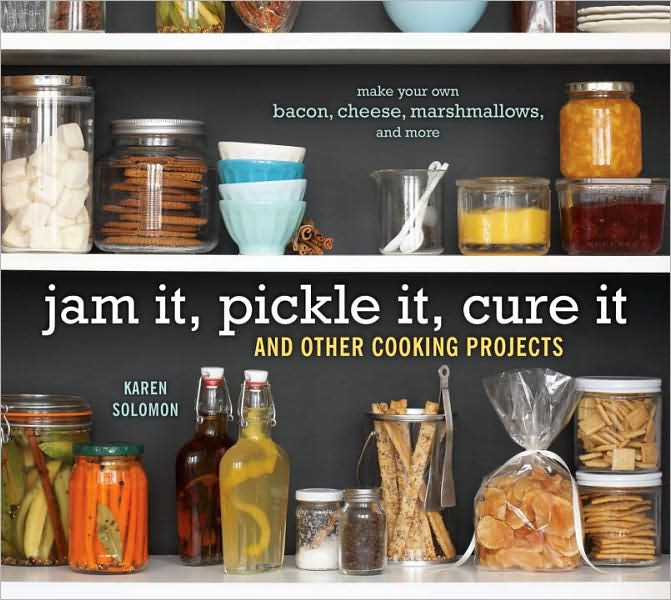Books |
Jam It, Pickle It, Cure It: And Other Cooking Projects
Karen Solomon
By
Published: Jun 01, 2009
Category:
Food and Wine
If you’ve been paying attention — if not, go to your room and read Michael Pollan’s In Defense of Food — it should be abundantly clear that the standard American diet is a gift that keeps on giving. Obesity, for one. Diabetes, for two. And, the ultimate gift, a premature death
“The way out,” Confucius said, “is through the door.” In this case, the supermarket door. Buy what you must have and leave. And then head to the nearest farm stand, farmer’s market or community garden.
Of late, more and more fresh-food shoppers have discovered this two-step, for the simple reason that they’d like fresh food. But year round? For most of us, that’s not easy. And so many now ask what used to be the extra-point question: How do I preserve vegetables and fruits?
The good news is that your old image of boiling and sterilizing in a laboratory environment is an antique that can be safely retired. Now all you need is a dishwasher, clean jars and paper towels. Which means you lack an excuse.
You certainly have reasons to learn to store food you can believe in. High food prices encourage you. Ditto the food safety scandals that give cable news something new to scare you about every week or so. For those who are jobless, home processing sure beats Judge Judy. And for those who like to spend time in the kitchen with friends and family, this is the contemporary bonding equivalent of “Little House on the Prairie”.
Whatever the reason, sales of home canning equipment are up 50 percent over last year. And with two good books just out, they could rise a bit more.
Well-Preserved: Recipes and Techniques for Putting Up Small Batches of Seasonal Foods is by Eugenia Bone, co-author of the excellent Italian Family Dining: Recipes, Menus, and Memories of Meals with a Great American Food Family. Bone is a busy woman, so she’s straightforward in her writing and streamlined in her techniques.
The more amusing book is Karen Solomon’s Jam It, Pickle It, Cure It: And Other Cooking Projects. She’s so enthusiastic about homemade foods she makes her own crackers and potato chips (though she concedes the chips require “mad knife skills”). She cheats — bless her — in her mayonnaise, substituting a food processor or blender for long duty with a whisk. And her jam recipe is idiot proof.
Solomon goes far outside the canning categories, which delights me — to a point. Pasta dough? Food snobs say dried pasta is better, anyway. Gravlax? Salt cod? Smoked trout? I think not. But then she offers a bacon recipe — yes: you can cure your own bacon — that’s so easy you’ll want to add pork belly to your shopping list.
I’m not likely to make my own marshmallows or beef jerky, but frozen mango and lime pops sound like a cold compress on a hot day. And watermelon pops. And Arnold Palmer (tea and lemonade) pops. I’m looking forward to making my own ginger beer — just four ingredients, one of them water. And, yes, I think I can wait 8 weeks for my limoncello (vodka, lemons, sugar and water) to process.
Which recipe to feature? Why, America’s sweetheart.
Regular Ol’ Tomato Ketchup (but better)
makes about 3 cups
1 large yellow onion, peeled and quartered
1 28-oz. can of whole tomatoes
2 Tbsp. vegetable oil
2 tsp. salt
1/3 cup packed brown sugar
1/2 cup champagne vinegar
1 cinnamon stick
1 bay leaf
5 whole cloves
5 cardamom pods, crushed
1 star anise
10 whole black peppercorns
1 tsp. Hungarian paprika
Salt and pepper to taste
Pour the tomatoes and their juice into the blender (seriously, the margarita machine, not the fancy food processor). Puree until totally smooth and set aside all but about a quarter cup of the liquid. To the remaining tomato in the blender, add the onion and puree.
In a large Dutch oven (bigger than you think, as this will splatter like a Pollock painting), heat the oil over medium-high heat. Add the onion puree and the salt and stir well, letting the liquid reduce and lightly brown, 8-10 minutes. Add the tomato, sugar, and vinegar, turn the heat to a low simmer, and reduce for about 15 minutes, uncovered, with an occasional stir. Add the cinnamon, bay leaf, cloves, cardamom, anise and peppercorns, stir well, and reduce 10 minutes more. Stir in the paprika and adjust seasoning.
Let the catsup cool and, if you’re finicky, remove the whole spices. Pour into a jar and chill overnight, or at least six hours. Refrigerated, the ketchup will keep at least two months.
To can it: Ladle into sterilized half-pint jars, leaving a quarter-inch headspace. Process in a hot-water bath for 15 minutes at altitudes up to 1,000 feet, 20 minutes at altitudes up the 6,000 feet, and 25 minutes at altitudes over 8,000 feet.
To buy “Jam It, Pickle It, Cure It” from Amazon.com, click here.
To buy “Well-Preserved” from Amazon.com, click here.


